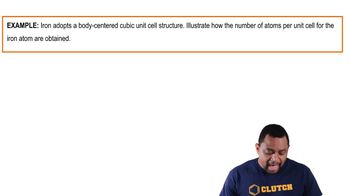Here are the essential concepts you must grasp in order to answer the question correctly.
Body-Centered Cubic (BCC) Structure
The body-centered cubic (BCC) structure is a type of crystal lattice where atoms are located at each corner of a cube and a single atom is positioned at the center of the cube. This arrangement allows for a coordination number of 8, meaning each atom is in contact with eight neighboring atoms. Understanding this structure is crucial for visualizing how potassium atoms are arranged in a solid state.
Recommended video:
Body Centered Cubic Example
Electron-Dot Structure
An electron-dot structure, or Lewis structure, represents the valence electrons of atoms within a molecule or solid. In the case of potassium, which has one valence electron, the electron-dot structure would show the central K atom with one dot, symbolizing its single valence electron, and the surrounding K atoms would also be represented with their own dots. This helps illustrate the bonding interactions between the atoms.
Recommended video:
Lewis Dot Structures: Ions
Metallic Bonding
Metallic bonding occurs when metal atoms share their pooled valence electrons, allowing for conductivity and malleability. In potassium, the delocalized electrons contribute to the metallic bond, which is essential for the stability of the BCC structure. The challenge in drawing the electron-dot structure lies in representing this delocalization accurately, as it does not conform to traditional covalent bonding models.
Recommended video:
 Verified step by step guidance
Verified step by step guidance


